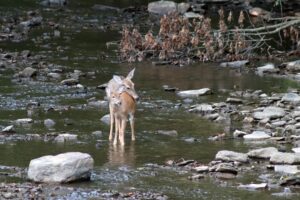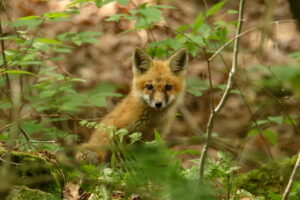
With spring drawing nearer each day, it is important to keep in mind what spring means to wildlife. For many wild mammals spring-with its mild weather and bountiful resources– is the time of year with the best conditions for giving birth and nursing young ones. With this in mind, it is important for humans to understand how to properly appreciate these young animals without disturbing them or harming them unknowingly.

Photo by Deidre States Smith, Yellow Creek State Park
How to Appropriately Interact with Young Wildlife
The best thing to do when encountering young wildlife is to leave them be, even if they appear to be alone. This is very important as an animal may appear to be alone, when in fact they are not. It is completely normal for young wildlife to be left alone by their mothers/parents for periods of time while the mother/parents is off gathering resources. The thing that keeps many forest animals safe is laying still and being quiet. When humans approach them or make too much noise near them it can draw predators directly to the baby animals. The best way to appreciate young wildlife, in fact all wildlife, is to keep a safe distance and keep noise to a minimum.
For those exploring with their canine friends, or any other pet, it is important to understand that the same rules apply. Be sure to keep pets on a leash of appropriate length (six feet if in a state park) and be cognizant of their activities.

Photo by Leigh Wolfe, Cook Forest State Park
Ways to Appreciate Young Wildlife Without Disturbing
While it may not be appropriate to approach young wildlife and pet them, there are other ways you can appreciate them without disturbing them. One of the best ways could be to take pictures from an appropriate distance or to use binoculars to watch them from afar. Another way would be to bring a field guide or checklist of local wildlife. If children are involved it is a great chance to teach them proper etiquette on how to interact with wildlife.

Photo by Dorothy Monahan, Oil Creek State Park
What to do if a Wild Animal Appears Sick or Injured
In the event you come across an animal that appears to be sick or injured, the best thing to do is to call a wildlife rehabilitator for assistance. Do not attempt to approach the animal or handle them without guidance. Even offering food or water could do more harm than good. It is best left to someone who specializes in helping wild animals as they know the proper precautions to take before helping the animal in need.
Sources
https://dnr.wisconsin.gov/newsroom/release/56216
Written by Garrett Leonard, PPFF Intern
Garrett, a PPFF intern, is a student at Shippensburg University pursuing his degree in Geoenvironmental Science
Bear feature photo by Dorothy Monahan, Oil Creek State Park




